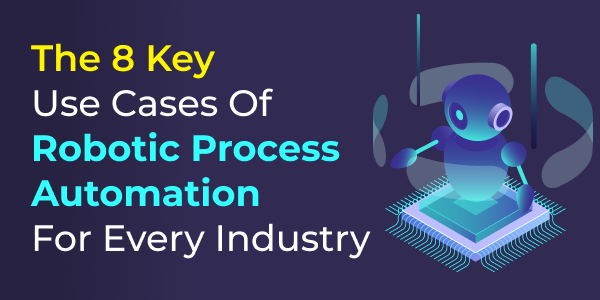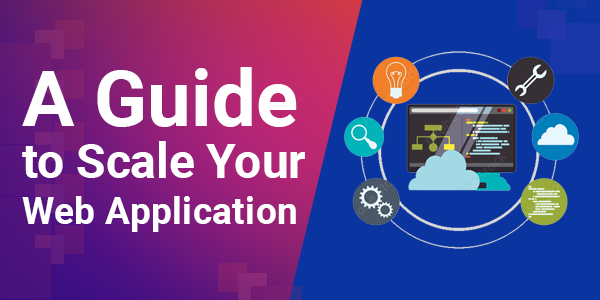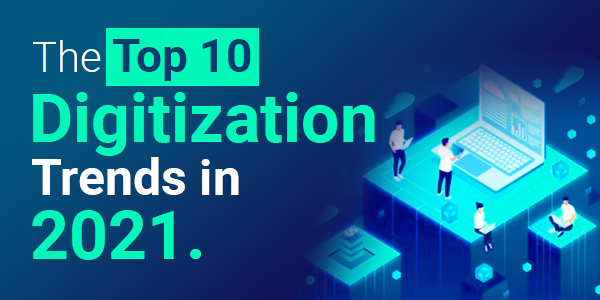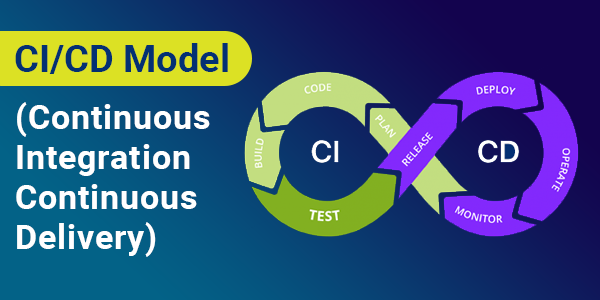The 8
key use cases of Robotic Process Automation for every industry

The modern-day enterprise market is driven by evolution and innovation. Everything that can boost your team’s productivity, saves time and money while performing critical business operations, and assists your growth strategies is what is positive investment. Combined with the economic impact of the pandemic that businesses had to deal with, it is high time to leverage technologies to ensure resilience, profitability, and productivity. And this is where robotic process automation (RPA) comes into play.
In the past few years, robotic process automation has been gaining widespread momentum owing to the benefits it offers to teams, people, and business. Overall, RPA allows businesses to accomplish their full potential, implement automated protocols, and reimagine operations with minimal investments.
Statistics suggest that the RPA market is growing exponentially and is expected to reach 13.4 billion dollars in 2030, a steep rise from 2 billion dollars in 2021. This empowers businesses to implement different RPA use cases in varied genres and business functions and embark new opportunities.
What is Robotic Process Automation?
Before we talk about the key use cases of RPA, let’s briefly understand what this novel technology is all about. In simple words, RPA allows you to automate repetitive and mundane tasks that require too much human intervention in back office and front office. With RPA, you can create automated tasks to successfully complete business operations while freeing up your workforce to focus on more creative roles.
For example, you can automate data entry, invoice processing, data extraction, etc. processes that occur regularly but require too much human indulgence. Additional examples include automating tasks in different departments like Sales, HR, Marketing, Operations, etc. in different industries like banking, retail, and manufacturing.
As you integrate RPA with your existing IT infrastructure,
The key use cases of Robotic Process Automation

Here we talk about the key use cases or areas where you can implement RPA procedures. However, you can go overboard and look for areas in your business where you would benefit from automation and then go along running RPA architectures for it.
#1: 24/7 customer support
As a business, your primary goal is to sell and earn money. However, as you scale and grow, ensuring quick responses to your customers becomes a hassle. With automation, you can deliver expected results to your customers, sort queries as per their urgency, and let robots respond to the initial customer requests.
This automated system will segregate queries into different categories like tech, service, sales, finance, etc., which means that they will now be directed to the right department. Moreover, you no longer have to move requests from one executive to the other as the entire process is now automated and streamlined.
#2: Invoice processing
In the sales department, it is always difficult to keep track of the invoices you need to send for payments and those that you have to clear. If you handle a large volume of invoices, you know how this mundane task can lead to delayed or incorrect invoices. Then, you encounter challenges around different formats, consolidating information from various sources before preparing an invoice, and sending them across on the right dates. Moreover, you also have to keep a track of vendors who haven’t paid yet and send across timely reminders to them.
All this worry can be sorted with robotic process automation. You can automate the paper-based invoice format via OCR. Also, you can run rules with RPA to automate data collection, reconciliation errors, and boost decision-making for invoice processing. As you don’t need your human workforce to take care of invoices, they can now focus on other tasks at-hand.
#3: Comparing prices in bulk orders
Often, you buy raw materials in bulk to manufacture products or provide services. The cost of your purchases can impact the company’s revenue or profits, and then you have your staff researching online to make an informed decision. This research requires tedious hours, which is why you must automate this process to save time and make better purchasing decisions.
Integrating it with RPA, allows you to compare prices from different vendors along with their attributes and quality. This way, you can buy the best raw materials at the best possible prices.
#4: Storing and securing customer information
Businesses today deal with a magnanimous amount of data, all generated via their customers. One of the major problems you encounter is sorting, storing, and organizing this data in a proper format to ensure required accessibility. Robotic process automation can help you achieve this goal. You can design an RPA system which automatically categorizes customer data into name, address, contact information, purchase history, preferences, important dates like birthdays and anniversaries. This system will be available at the disposal of your customer care executives, salespersons, and other employees. You can even set rules and protocols to this system to ensure no one except the intended workforce views this database, hence securing your customer information.
Since you don’t have to enter this information manually, there is no doubt regarding its accuracy. Moreover, this frees your team from the mundane tasks, preserving their creative power for other jobs.
#5: Extracting data from different formats
The most pressing issue with organizations is that most data is stored in a haphazard manner. It can appear as handwritten notes or different excels or from an editable text. This is where your professionals struggle to find and read the correct information and store it into the system. However, through RPA’s optical character recognition technology, you can easily read information from different sources and seamlessly enter it to the system. Where your employees spent their 10-20% of their man hours, now they can direct all that time and efforts into something more productive.
#6: Assistance with BOM, data migration and ERP automation
RPA serves several use cases in the manufacturing industry. In fact, RPA has led to the automation of production units and associated tasks like product assembling, quality check, packaging, and back-end operations. Moreover, RPA has assisted manufacturing companies in registering 40% savings in operational costs.
- Leveraging RPA, you can now easily create a bill of materials faster and accurately
- Seamlessly migrate data from your legacy systems to the new ones, while ensuring time and cost savings.
- Automate inventory management, account payable and receivable, and invoice management to boost efficiency.
#7: Improving customer experience in the insurance industry
Customer information is a treasure trove for insurance service providers. For serving customers with competitive experiences, the following are the use cases implemented:
- RPA helps processing claims 75% faster than the traditional approach. Moreover, it eliminates preexisting issues around the quality, timeliness, and accuracy of the process.
- Insurance automation accelerates the form registration process by 40%. The RPA induced artificially intelligent system automatically reduces workload and boosts customer satisfaction.
- Insurance providers have to stay compliant with several standard and policies. These include the HIPAA privacy rules and PCI standards. Although the regulatory protocols can vary from one insurance provider to the other, but proper RPA strategies can help you automate notifications and updates.
- RPA assists with risk mitigation by accurately processing data automatically from internal and external sources. RPA models in action troubleshoot all the current issues and make predictions for the future. This ensures faster and accurate delivery of work.
#8: Effortless banking solutions while saving operational costs
RPA in banking assists with reducing errors and human labour significantly. As per statistics, RPA reduces 30-70% of processing costs and turnaround time. The following are some noteworthy use cases of RPA in the banking industry:
- RPA assists banks with several customer service requests from onboarding to verifying customer details, loan inquiry, etc. As all these processes are accomplished faster and accurately, it helps banks in maintaining customer loyalty.
- The traditional account payable operations involved collecting invoices from vendors via OCR, validating the data, and then processing the payments. However, with RPA, this entire process is now automated, and the amount is credited to the account automatically. Moreover, RPA systems can also send out notifications to customers for required documents or for payments with superior accuracy
- RPA also helps in fulfilling all the KYC related operations. Such a system can effectively gather customer information, validate, and process it with higher productivity and quality. As the errors around the same are reduced significantly, it results in round-the-clock process optimization.
- An RPA system can effectively automate background checks and validation, speeding up the credit card dispatching process. The same goes with the scrutiny for mortgage. With RAP algorithms, you can boost process productivity and efficiency.
- Banks are always under the threat of frauds and security breaches. Automating fraud detection processes will allow your systems to identify accounts that are likely to cause trouble and flag them.
Building a Robotic process automation model for your business
Apart from the above mentioned, there are several other ways you can implement RPA technology for your business. Of course, it requires some practice and the assistance of experienced professionals, but once you adapt to the automation world, you will notice a significant boost in your productivity and workforce satisfaction.
At Triazine, we’ve built custom RPA systems for companies global-wide and can help you explore many more use cases around the same. We follow a sprint RPA model that allows your business to start small, automate one process at a time and grow from there. Connect with our experts if you’re looking to unleash the power of automation for your business.
Featured Articles
Latest Articles

How UI/UX Plays an Important Role in App Development
How many times have you opened an app and thought the button was misplayed, the design team could have chosen better col .. Read More
By Vikash Srivastava | Apr 20, 2023

How is UiPath automating cybersecurity operations?
State of the CIO Study 2022 reports that over 51% CIOs have commenced focussing their time and expertise on security man .. Read More
By Abhinav Kumar | Aug 02, 2022

The 8 key use cases of Robotic Process Automation for every industry
The modern-day enterprise market is driven by evolution and innovation. Everything that can boost your team’s producti .. Read More
By Abhinav Kumar | May 25, 2022

The 7 key tenets of a digital transformation strategy
Since the pandemic, there has been a stark change in how enterprises communicate, operate, and plan for the future. Acce .. Read More
By Abhinav Kumar | Mar 21, 2022

How to Build Effective and Scalable Web Applications – The Best Practices
A big part of any web application development is its capacity to scale in the later growth stages. Irrespective of the p .. Read More
By Vikash Srivastava | Oct 22, 2021

How Artificial Intelligence in Mobile Banking is a Game-Changer?
Let’s start this discussion with a simple question, how many of you still stand in queues outside banks just to get ge .. Read More
By Abhinav Kumar | Oct 14, 2021

Utility mobile application development role in the digital transformation
What is utility mobile application development and why it matters?At this point, mobile applications have become an inal .. Read More
By Vikash Srivastava | Oct 11, 2021

How to build a successful and agile offshore development team?
As a global trend, outsourced software development holds a market size of $92.5 billion, and a significant chunk of .. Read More
By Abhinav Kumar | Sep 30, 2021

What is VAPT and does your organization need it?
What is VAPT and does your organization need it? To no one's wonder, there is a flood of applications and softwar .. Read More
By Vikash Srivastava | Sep 08, 2021

The top 11 FinTech trends to achieve digital transformation
The top 11 FinTech trends to achieve digital transformation Similar to other industrial verticals heavily impacte .. Read More
By Abhinav Kumar | Sep 08, 2021

The Next Normal: The Top 10 digitization trends for enterprises in 2021 and beyond
The Next Normal: The Top 10 digitization trends for enterprises in 2021 and beyond Nobody knew where 2020 and 202 .. Read More
By | Sep 07, 2021

CI/CD Model: what and why it matters in software development
CI/CD Model: what and why it matters in software development There was a time when software development wa .. Read More
By Vikash Srivastava | Jun 08, 2021

What Is Legacy Migration and Why to Consider It
What Is Legacy Migration and Why to Consider It? Software technologies and applications are on the road to an ine .. Read More
By | May 25, 2021

What Makes CMMI Appraisal Necessary for Software Development Companies ?
What Makes CMMI Appraisal Necessary for Software Development Companies? During software development, your product .. Read More
By Abhinav Kumar | May 10, 2021

The Top 11 Mobile App Development Trends You Must Know for 2021
The Top 11 Mobile App Development Trends You Must Know for 2021 We all have so many expectations from 2021, don� .. Read More
By Vikash Srivastava | May 04, 2021

2- Why to choose react native for mobile app development project?
React Native for mobile app development: Is it the right choice? For the 21st century, mobile phones are like sou .. Read More
By Abhinav Kumar | May 04, 2021

How Digital Transformation Impacts Software Development Services
Digital Transformation and its impact on Software Development Lifecycle Today's industrial landscape ta .. Read More
By | May 03, 2021

What is the right price for developing a mobile app?
What is the price to develop an iPhone app? Or rather, how much does mobile app development cost? Well, Kudos to you bec .. Read More
By | Apr 07, 2021

Should I use Flutter for my next Mobile App Development project?
So, what was the mobile app development story before Flutter? Let's consider mobile application develo .. Read More
By | Mar 17, 2021

Is there any right pricing strategy for mobile app development?
No phrase can appropriately describe the accelerating mobile app development market! Definitely, it is on a consistent b .. Read More
By Abhinav Kumar | Feb 22, 2021

Mobile App Development: Freelancer or a Software Development Company
So, you’ve decided to build software, and now you’re faced with the debatable and inevitable question: software dev .. Read More
By | Jan 21, 2021

Hybrid Mobile App Vs. Native Mobile App… Am I Making A Right Choice?
This seems to be a million-dollar question when it comes for making a choice between hybrid mobile app or native mobile .. Read More
By Vikash Srivastava | Jan 11, 2021

5 trends that will be influencing mobile app development in 2019
We live in a smartphone-driven world and mobile apps are now an integral part of our lives. From day-to-day commute to g .. Read More
By Abhinav Kumar | Jun 11, 2019
